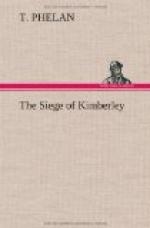With Monday came three despatch-riders who reported that heavy fighting had taken place—somewhere; the authorities declined to tell us where. The Boers remained docile all day; the heat was oppressive, but their silence was more generally attributed to a tardy realisation of their position. The military were unusually alert and watchful. The public graciously approved of this watchfulness, but pooh-poohed the danger of invasion. We were tired hearing day after day that an attack on the town was to be made “to-night”; it was to be “taken” six nights out of every seven, the last being, if I mistake not, the one on which General French was feted at the Kimberley Club.
Elaborate arrangements were made on Tuesday for the better protection of our cattle. The quadrupeds, Dutch and English, were on the best of terms—a happy augury, surely, for the amity which would unite the bipeds of the land when the war was done. We had a batch of natives employed digging trenches for the cattle-guards. A patrol was at hand to nip in the bud any interference with the work which might be contemplated. If the Boers did interfere, so much the better; interference would involve a fight, and from a friendly tussle in the sun the patrol was not averse. On the south and west sides the enemy still laboured at their fortifications. We knew not what to make of this; it nonplussed us. We had ceased ascribing it to want of knowledge: for we had, reluctantly, let it down on us that the Boers knew as much of the Column’s movements as we did ourselves. But of course we also knew that the Boer was a child in such matters as generalship and tactics.
Every afternoon, at this period, the “child” delighted in trying to hit the head-gear of the Premier Mine. Whether it was the red flag that floated at the top or the thing itself he sought to tatter is uncertain. At any rate, it was no easy matter to hit the head-gear, as the gunner had long since discovered, nor, could he hit it, to smash it. Hundreds of shells were thrown at it, but it was never struck, and to damage it materially it would be necessary to strike it more than once. Its substance was tough—what Bismarck would have called iron painted to look like wood. Another object of




